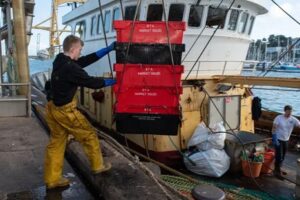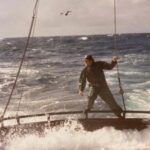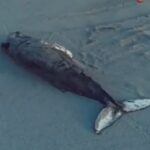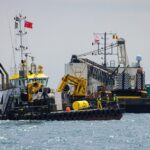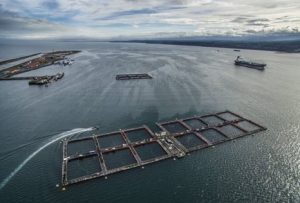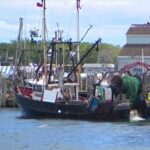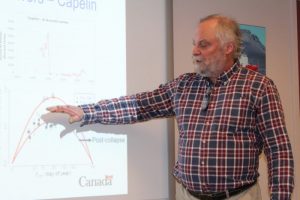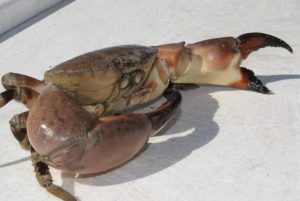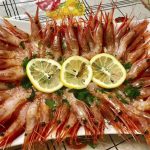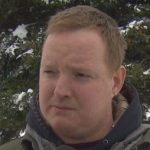Tag Archives: Stephanie Mangini
Alaska’s 2013 Commercial Halibut Season Wrap Up – This is Fish Radio. I’m Stephanie Mangini.
 At noon today long liners are retiring their halibut gear for the remainder of 2013. Early numbers show that there was over a million pounds left of the nearly 22 million pound harvest. That could leave quite a hefty sum of fish bucks floating in the water. listen@fishradio 15:51
At noon today long liners are retiring their halibut gear for the remainder of 2013. Early numbers show that there was over a million pounds left of the nearly 22 million pound harvest. That could leave quite a hefty sum of fish bucks floating in the water. listen@fishradio 15:51
Kodiak fishermen’s likes/dislikes about fishing – This is Fish Radio. I’m Stephanie Mangini
 Where another day at the office is common to most, it’s another day on the water for professional fisherman. Fish Radio asked Kodiak fishermen their favorite and least favorite things about fishing. more@fishradio 14:04
Where another day at the office is common to most, it’s another day on the water for professional fisherman. Fish Radio asked Kodiak fishermen their favorite and least favorite things about fishing. more@fishradio 14:04
This is Fish Radio. I’m Stephanie Mangini. Diving for dollars. Hear more after this . . .
 Diving for sea cucumbers, geoduck clams, and sea urchins is a unique yet very lucrative fishery. Southeast holds the title for the biggest dive fisheries when it opens in the fall. Around 150 divers are searching the bottom of the ocean for sea cumbers this year. listen@fishradio 16:51
Diving for sea cucumbers, geoduck clams, and sea urchins is a unique yet very lucrative fishery. Southeast holds the title for the biggest dive fisheries when it opens in the fall. Around 150 divers are searching the bottom of the ocean for sea cumbers this year. listen@fishradio 16:51
This is Fish Radio. I’m Stephanie Mangini. Crab season stats and salmon tallies. More fisheries updates after this…
 October 15th marks the start for Bristol Bay Red kings, Bering Sea Tanners and Snow crab. The Red King crab catch is up this year by 91/2 percent with 8.6 million pounds. Tanners is reopened this year with a 3 million pound quota. The Bering Sea Snow crab catch is down by nearly 19% at just under 54 million pounds. Due to government shutdown,,listen@fishradio 12:48
October 15th marks the start for Bristol Bay Red kings, Bering Sea Tanners and Snow crab. The Red King crab catch is up this year by 91/2 percent with 8.6 million pounds. Tanners is reopened this year with a 3 million pound quota. The Bering Sea Snow crab catch is down by nearly 19% at just under 54 million pounds. Due to government shutdown,,listen@fishradio 12:48
Federal Fisheries Frustration
 This is Fish Radio. I’m Stephanie Mangini. Federal Fisheries Frustration. Hear more after this…@alaskafishradio 15:12
This is Fish Radio. I’m Stephanie Mangini. Federal Fisheries Frustration. Hear more after this…@alaskafishradio 15:12
Every Halibut Counts – This is Fish Radio. I’m Stephanie Mangini.
 Finding ways to gently release halibut back into the water is the goal of a collaboration by the National Fish and Wildlife Foundation’s Fishermen’s Innovative Fund. The Alaska Marine Conservation Council, Alaska Sea Grant’s Marine Advisory program, and the Southeast charter industry are developing new ideas, technologies, and management strategies to better protect our halibut population. more@fishradio 15:07
Finding ways to gently release halibut back into the water is the goal of a collaboration by the National Fish and Wildlife Foundation’s Fishermen’s Innovative Fund. The Alaska Marine Conservation Council, Alaska Sea Grant’s Marine Advisory program, and the Southeast charter industry are developing new ideas, technologies, and management strategies to better protect our halibut population. more@fishradio 15:07
Hot Agendas Being Tackled by the North Pacific Council – This is Fish Radio. I’m Stephanie Mangini.
 Gulf of Alaska By-catch and the observer program are in the hot seat. Hear more after this . . .listen@fishradio 13:05
Gulf of Alaska By-catch and the observer program are in the hot seat. Hear more after this . . .listen@fishradio 13:05
Bringing Your Livelihood to the Table (at that Council Meeting) Makes an Impact
 Fish managers of the North Pacific Council need the boots on deck prospective. Bringing a first hand experience to the table can make a huge impact on decisions made in the fishing industry. When the council sits down this week by catch and on board observers are just a few hot topics they are tackling. more@fishradio 14:59
Fish managers of the North Pacific Council need the boots on deck prospective. Bringing a first hand experience to the table can make a huge impact on decisions made in the fishing industry. When the council sits down this week by catch and on board observers are just a few hot topics they are tackling. more@fishradio 14:59
This is Fish Radio. I’m Stephanie Mangini. No Effort, Bad Prices, and Low Fish Counts… Fall Cod is a Snooze
 The fall Pacific cod B season hasn’t made many waves since opening on September 1st. The 9.6 million pound Central Gulf harvest has hardly taken a hit. Only a few boats have shown effort in the pot cod fishery, compared to 2012 when around 35 vessels were actively fishing the 12 million pound quota. more@fishradio 17:58
The fall Pacific cod B season hasn’t made many waves since opening on September 1st. The 9.6 million pound Central Gulf harvest has hardly taken a hit. Only a few boats have shown effort in the pot cod fishery, compared to 2012 when around 35 vessels were actively fishing the 12 million pound quota. more@fishradio 17:58
This is Fish Radio. I’m Stephanie Mangini. From the crab lab into the wild.- “Where we are now is actual experimentation in the wild.”
 Phase two of a seven year project takes place this week. NOAA biologists along with their star dive team are releasing 13,000 hatchery raised Alaska red king crab into their new home on Kodiak in Old harbor. The AKCRRAB project started back in 2006 and is a coalition of managers, scientists, academics, and industry. What began as a test in the NOAA crab lab to see if it was possible to raise crab in a hatchery setting will now be taken to a whole new level. more@alaskafishradio 21:28
Phase two of a seven year project takes place this week. NOAA biologists along with their star dive team are releasing 13,000 hatchery raised Alaska red king crab into their new home on Kodiak in Old harbor. The AKCRRAB project started back in 2006 and is a coalition of managers, scientists, academics, and industry. What began as a test in the NOAA crab lab to see if it was possible to raise crab in a hatchery setting will now be taken to a whole new level. more@alaskafishradio 21:28
Red King Crab Serial Killers – This is Fish Radio. I’m Stephanie Mangini.

Dive into Womens Bay, an inlet located on the island of Kodiak and you will find a graveyard of lost or abandoned crab pots or as NOAA’s diving biologist Pete Cummiskey likes to call “Ghost Pots more@fishradio 08:28
Alaska Fish Radio – Connecting Alaskas Communities to Their Working Waterfronts
 I’m Stephanie Mangini. Connecting Alaskas working waterfronts, Farmers began a trend when they started Community Supported Agriculture programs on the East coast. Fishermen quickly caught onto the concept developing their own Community Supported Fisheries . The Alaska Marine Conservation Councils Executive Director Kelly Harrell explains . .listen@fishradio 21:32
I’m Stephanie Mangini. Connecting Alaskas working waterfronts, Farmers began a trend when they started Community Supported Agriculture programs on the East coast. Fishermen quickly caught onto the concept developing their own Community Supported Fisheries . The Alaska Marine Conservation Councils Executive Director Kelly Harrell explains . .listen@fishradio 21:32

































